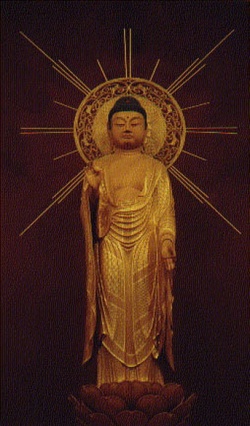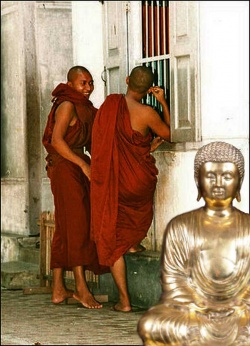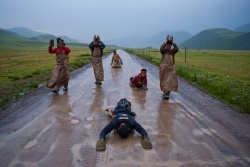Mahasanghika - the Earliest Vinaya?
The search goes on for something that we can identify as the earliest Vinaya, the principles of monastic conduct that have set the standard for Buddhist monastics from the Buddha until now. For scholars this is part of the enigmatically meaningful need to search for the origins of things. For myself as a practicing monk, it raises the question of how much should I regard various Vinaya guidelines as ‘authentic’, as stemming from the enlightened human to whom I have offered my life, and how much I should regard as the accumulation of traditions, adopted from time to time by monks as they see fit.
Charles Prebish claims to have answered this question, or at least to have made significant strides towards it. He says, in at least two articles, that we can regard the Mahāsaṅghika Vinaya as representing the oldest stratum of Vinaya texts available to us. He quotes an impressive series of authorities to support his claims. I would love to be convinced, but an examination of Prebish’s authorities reveals a rather different picture.
In 1977 Prebish and Jan Nattier published their ‘Mahāsāṁghika Origins’, claiming to deduce that the most reliable account of the root schism in Buddhism is found in the Mahāsaṅghika Śāriputraparipṛcchā. The Śāriputraparipṛcchā claims that the Mahāsaṅghika Vinaya is the original, and that the Sthavira Vinaya was expanded. Prebish & Nattier invoke the support of a range of scholars for the view that the Mahāsaṅghika is indeed the earliest, hence supporting the claim of the Śāriputraparipṛcchā. (Nattier and Prebish 221) They emphasize that each scholar has arrived at this conclusion using a different method.
Nearly twenty years later, Prebish repeated the claim, invoking the same scholars in the same way, and adding some new ones. (Prebish 189) It seems that in this interval he has not seen any reason to revise his views. I will base the following analysis on this later article, presenting each of Prebish’s claimed authorities in turn.
1. Bareau using the text length of the Śaikṣa section of the Prātimokṣa-sūtra: The pāṭimokkhas of the various schools are virtually identical, and the only substantial difference is the number of sekhiya rules, a minor section dealing with etiquette. I discuss the sekhiyas elsewhere, so won’t dwell on them here. I am happy to accept that the relative shortness of this section in the Mahāsaṅghika pāṭimokkhas is prima facie evidence for their earliness. It is hardly decisive, though, and badly requires supporting arguments.
2. Pachow using comparative Prātimokṣa study: This is slightly misleading, as the results of Pachow’s study in fact show little evidence for any difference between the pāṭimokkhas, and his conclusion, like Bareau’s, is based entirely on the sekhiyas. (Pachow 39) Pachow did, however, use a different method. Rather than simply counting the rules, he structurally analyzed a small section of 12 sekhiya rules, comparing the Chinese translations of the Sarvāstivāda and Mahāsaṅghika.
He concluded that the method of arrangement of the rules was more suited for memorization in the Sarvāstivāda version, and hence this must have been a later revision. This method, utilizing a small section of two Vinayas, is obviously inadequate to prove anything, and is barely even suggestive. At most, even allowing Pachow’s slender thesis, it would show that this section of rules had been rearranged, and would tell us nothing about the rest of the Vinaya.
3. Hofiger using all second council materials in the various Vinayas: This claim rests on the well-known fact that the account of the Second Council in the Mahāsaṅghika, while substantially similar to the others, is much shorter and only enumerates one offense rather than the ten found in all others. This relevance of this claim disappears, however, when we notice that the Mahāsaṅghika Vinaya regularly abbreviates narrative material. This is a literary feature of the Mahāsaṅghika Vinaya in general, and not particular to the Second Council. The abbreviations are sometimes marked with specific instructions to expand ‘as in the such & such sutra’, so it is clear that this narrative abbreviation is the result of a deliberate later editorial revision.
4. Frauwallner using an analysis of the Skandhakas of the various Vinayas: Frauwallner famously attempted to trace the Skandhaka section of all existing Vinayas back to one source. One of the serious problems with his heroic effort is the Mahāsaṅghika Vinaya, which has a Skandhaka section quite different to that of other Vinayas. Nevertheless, Frauwallner argued that it did indeed hark back to the same source, but the original Skandhaka had outgrown its usefulness, being more artistic than systematic:
‘Under these circumstances the temptation was very strong to try and put a new arrangement in place of the old one, which was no longer understood; and the Mahāsaṅghika have made this attempt. They tried to substitute for the old artistic shaping of the materials a new purely systematic arrangement.’ (Frauwallner 199) Frauwallner goes on to detail how this happened. His understanding of the Mahāsaṅghika Vinaya is quite consistent, being repeated a number of times through his work, and nowhere does he say it was the earliest Vinaya; rather, it was a later reshaping of earlier materials.
5. Roth using an examination of the language and grammar of the Mahāsaṅghika-Lokuttaravādin texts preserved in Sanskrit: We must first note that the texts Roth uses are of necessity the Indic texts, while the above remarks were made on the basis of the Chinese Mahāsaṅghika Vinaya. There is, of course, no guarantee that all the texts within one tradition would hail from the same time, or should have a similar redaction history. Roth says: ‘The language of our text is indeed a language in the transitional state from Prakrit to Sanskrit. I would like to call it a language on the way which has been caught and fixed in the middle of its transformations and changes somehow…’ (Roth lvi) This sees the language as a transition between the earlier Middle-Indic forms such as Pali, and the later Sanskrit.
This agrees with Edgerton, who literally ‘wrote the book’ on Buddhist Hybrid Sanskrit, e.g.: ‘Buddhist Hybrid Sanskrit tradition as a whole, starts from, or goes back to, an early Buddhist canon, or quasi-canon, which was composed not in Sanskrit but in a Middle Indic vernacular…’ (Edgerton 8) Later Roth is more specific in tying the language down: ‘The general feature of this language… leads us to the west of India, during the era of the Mathura inscriptions.’ (Roth lx) These inscriptions date from the 1st Century at the earliest. (Lamotte 523ff) In addition, Roth suggests, like Frauwallner, that the existing Lokuttaravāda Vinaya, particularly the 8 garudhammas section, shows the signs of later rearrangement:
‘As a result of joining different portions originally belonging to different sections of the Vinaya in this manner, the complete set of the Bhikṣuṇī-Vinaya of the Ārya-Mahāsaṅghika-Lokuttaravādin was composed.’ (Roth xlvii). He also suggests that some of the vocabulary shows ‘influences of a later period’ (Roth xliii), such as the use of the word yogācāra, which has ‘entered our text from later strata of Buddhist tradition not belonging to the ancient Vinaya’. (Roth xliv) Thus both linguistically and structurally Roth suggests the Mahāsaṅghika Lokuttaravāda shows signs of being later than other Vinayas.
6. The conclusion of the Chinese Fa-xiang, who regarded the Mahāsaṅghika Vinaya as the original: This merely reflects the opinions of the school from whom the Vinaya was obtained, and is irrelevant to a historical discussion.
7. Cousins agrees with the above conclusion heartily: Prebish refers to Cousins’ comments on the Śāriputraparipṛcchā: ‘Rather, it sees the Mahāsaṅghika as the conservative party which has preserved the original Vinaya unchanged against the reformist attempts to create a reorganized and stricter version.’ (Cousins 56) And: ‘Clearly the Mahāsaṅghikas are in fact a school claiming to follow the Vinaya of the original, undivided saṅgha, i.e. the mahāsaṅgha.’ (Cousins 57) It seems to have escaped Prebish’s notice that in these statements Cousins was presenting the Śāriputraparipṛcchā’s point of view, not his own.
This is puzzling, for in a later section of the same article, called ‘Mahāsaṅghika Origins’ and clearly intended as a response to Nattier and Prebish’s earlier work, Cousins makes his views quite explicit: ‘Human nature being what it is, it is perfectly credible that the Mahāsaṅghikas believed that they had preserved the original form of the Vinaya which had been altered by others. Their opponents were unlikely to have agreed.
They probably felt that things had become lax and it was necessary to restore the pristine teachings. In such a dispute historians should take sides.’ (Cousins 67) In the note to this, Cousins makes it plain that he does not agree with Prebish, whether ‘heartily’ or not: ‘Nattier and Prebish accept the Mahāsaṅghika account too readily.’ (Cousins 81)
To sum up, the sources that Prebish invokes to prove the earliness of the Mahāsaṅghika Vinaya either are weak (Bareau and Pachow), mistaken (Hofiger), sectarian (Fa-xiang), or in fact prove the very opposite of what Prebish wants (Frauwallner, Roth, Cousins). Worryingly, Prebish has repeatedly misrepresented his sources.
We have proven Prebish’s claims to be baseless. This leaves open the question of where the Mahāsaṅghika Vinaya should be dated relative to the other Vinayas. We have already mentioned a few considerations that would suggest that it might be later than at least some Vinayas: the language is not early; there are signs of restructuring (especially the garudhammas) and later abbreviation of passages; some terminology is late. In addition I would note the appearance of certain avadānas that are absent from the Pali; the presence of rules governing stupa construction, again absent from the Pali;[1] the Sanskrit pāṭimokkha adds the precise calendar date and time for the laying down of the pārājika rules;
the inheritance rules appear to be more evolved than those in Pali; there is evidently a sanction for king’s involvement in the Sangha, again absent from the Pali; and it mentions the copying of sutras, which once more is absent from the Pali.[2] (I apologize for relying heavily on the Pali here, showing my regrettable bias; but perhaps I might be excused, since most commentators, fundamentalist claims aside, have seen this Vinaya as the main competitor with the Mahāsaṅghika for the title of ‘earliest Vinaya’.) I would see all these points as suggestive of a later date for the Mahāsaṅghika Vinaya, at least relative to the Pali.
Perhaps the only substantial contribution to be made to this problem since the time of Frauwallner is the essay by Shayne Clarke on the Vinaya mātikās. These are a class of Vinaya literature, with several examples preserved in Chinese and Tibetan. They have been even less studied than the ‘main’ Vinayas, but Clarke takes up the intriguing suggestion by Yin Shun in his Yuanshi fojiao shengdian zhi jicheng that these mātikās may have been the foundation for the Skandhaka literature.
Clarke analyzes several sections of the Mahāsaṅghika Vinaya, which Frauwallner had treated as reorganized Skandhaka sections, and shows that in important ways they correspond more closely with features in the mātikās than they do with the Sthavira Vinayas. Clarke’s conclusion:
‘Indeed, it is possible that the mātṛkās represent a core (‘seed’) Vinaya text which predates the development of sectarian literature. If this is the case perhaps the only chance of either proving or disproving such is through a detailed study of the extant Vinaya corpus with particular attention to the mātṛkā texts. (Clarke 114)
Clarke’s initial foray into such analysis appears to show that the Mahāsaṅghika Vinaya has closer connections with the mātikās than the Sthavira Vinayas in certain respects, and might in those respects represent an earlier tradition. But this rests on the so far unproven thesis that the Vinaya mātikās are prior to the Vinaya texts, that is, that they are seeds for development, not later abstractions. No doubt the real situation is complex, and we cannot expect to find that the mātikās are unambiguously earlier than the rest of the Vinaya texts in all respects. Also, it remains to be seen whether some or all of the Sthavira Vinayas might have certain other connections with the mātikās not shared by the Mahāsaṅghika.
The matter does not rest there, by any means. All early Buddhist literature is of a composite nature, and incorporates material from many different eras. We sometimes wonder whether the texts include things that go back to the Buddha himself. But it has been proven since the early days of Buddhist scholarship that significant amounts of material, especially some of the Jātakas and Avadānas, in fact pre-date the Buddha. They stem from the floating literature of oral story-telling and were adopted into Buddhist context from existing fables and tales.
Similarly, certain phrases in the Pali canon can be traced back to Vedic or Upanishadic precedents. The material in the large Buddhist collections must span several centuries in date, in some cases over a millennium. In trying to fix a particular early Buddhist textual corpus as ‘early’ or ‘late’, we are merely making a generalization to serve as the basis for exceptions.
[1] Schopen’s theory that these rules have been removed by the later Mahāvihāravāsins would make an excellent plot for the X-files.





